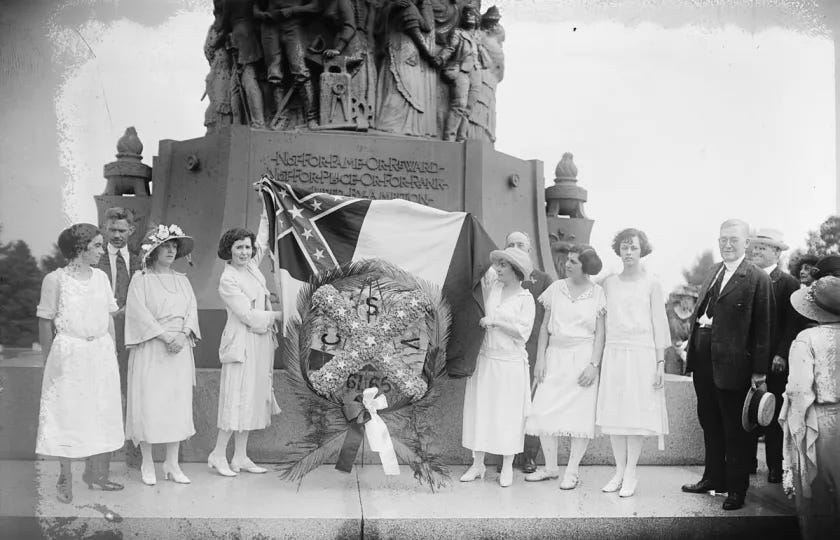As you all know the Confederate monument in Arlington National Cemetery is scheduled to be removed before the end of the year. There is some discussion that this may occur as soon as December 18, but I have been unable to confirm this date.
A group called Defend Arlington filed a lawsuit in an attempt to prevent the removal of the monument and today a group of Republican congressmen, led by Georgia’s Andrew Clyde, have written a letter to Defense Secretary Lloyd Austin demanding he halt the monument’s removal.
The letter includes a now widely accepted assumption that the Confederate monument in Arlington National Cemetery is a symbol of reconciliation. They reference approvingly of Jim Webb’s recent op-ed in the Wall Street Journal, which I dismantled in a recent blog post.
The attempt to transform and distort the history of this monument is most clearly seen in the decision to refer to it as the “Reconciliation Monument.”
This is a gross distortion of the events that led to the dedication of the monument, a misinterpretation of the monument itself as well as the United Daughters of the Confederacy (UDC), which oversaw its fundraising and selection of sculptor. The most egregious claim in the letter is the following:
[T]he Reconciliation Monument does not honor nor commemorate the Confederacy; the memorial commemorates reconciliation and national unity.
It’s not only a misinterpretation of the monument and the intentions of the UDC, the claim suggests to me that few, if any, of the signers of this document have ever bothered to visit the site or even look at a photograph of the monument.
As I have said numerous times before, the UDC was not in the business of reconciling with the rest of the nation other than on their own terms and that included recognizing that the Confederate cause was both morally and constitutionally justified.
Yes, you can find plenty of references to “reunion” and “reconciliation” throughout the process leading to and during the dedication of the monument, but reconciliation never occurred in a vacuum.
To the extent that reconciliation was experienced, it came at a horrible price for African Americans. It included the mythologizing and erasure of the legacy of emancipation and Black military service. Just look at the Arlington monument for the clearest evidence of this distortion.
Reconciliation occurred at the same time as the rise of Jim Crow and the rebirth of the Ku Klux Klan. Annie Cooper Burton, who served as president of the Wade Hampton chapter in Los Angeles and author of The Ku Klux Klan, believed that every “clubhouse” should have a memorial tablet dedicated ot the Klan.
But as historian Karen Cox points out in her study of the UDC, the organization was never interested in reconciliation unless it was on its own terms:
At the time of the unveiling, most members of the UDC did not honestly believe that reconciliation had occurred between the North and the South. The Daughters, in particular, were loath to speak of reconciliation as long as northerners regarded southerners as traitors. Members of Confederate organizations had long railed against the ‘biased’ interpretation of the Civil War by northern historians. The Arlington monument, however, looks like a three-dimensional pro-Confederate text, or, one contemporary observer put it, ‘history in bronze.’ Indeed, the plinth is marked by scenes inspried by the Lost Cause narrative, including images of heroic men, self-sacrificing women, and faithful slaves. For white southerners, the Arlington monument was a success, because it represented reconciliation in terms they found acceptable. It offered no compromises in its interpretation of the Civil War, and its place in the nation’s cemetery honors Confederate soldiers as American patriots. (pp. 71-72)
In short, what Rep. Clyde and other defenders essentially want to do is de-Confederatize, if you will, the Arlington monument by turning into something that all Americans (white and Black) should revere. It asks the public to ignore the monument itself.
It is ironic that the ladies of the UDC would be the first to stand up and challenge Rep. Clyde’s interpretation of the monument as a symbol of reconciliation.
I wish the supporters of this monument would have the courage to openly defend it for what it was intended: as an unapologetic celebration of the Confederacy states’ rights, and slavery.
It’s unclear whether this letter will have any impact. I suspect that the removal of the monument will proceed on schedule.
My hope is that part of it can be placed in a museum to help educate the public on how a monument that celebrates the Confederacy and distorts the history of African Americans, just a short walk from the final resiting place of hundreds of United States Colored Troops, was ever possible.







The defenders are also now arguing that removing the monument's artwork is
A) antisemitic because the sculptor was Jewish, including comparisons to Hamas!
B) anti-Gay, because the sculptor was, presumably, gay.
It's like they're trying to formulate an argument in a language they don't quite understand.
I'm glad you are following this story, and keeping us updated. Arlington National Cemetery is very clear at its website about the monument's false narratives about slavery and its support of the Lost Cause. The monument's Latin inscription reads: “Victrix causa diis placuit sed victa Caton”: “The victorious cause was pleasing to the gods, but the lost cause to Cato.” (Cato the Younger viewed Caesar as a despot, similar to how the Confederates viewed Lincoln.)
I am curious to see whether the statue will wind up at VMI's museum at the New Market Battlefield, as Glenn Youngkin wants. VMI is not likely to give it proper contextualization. More likely they would invite Webb to speak.